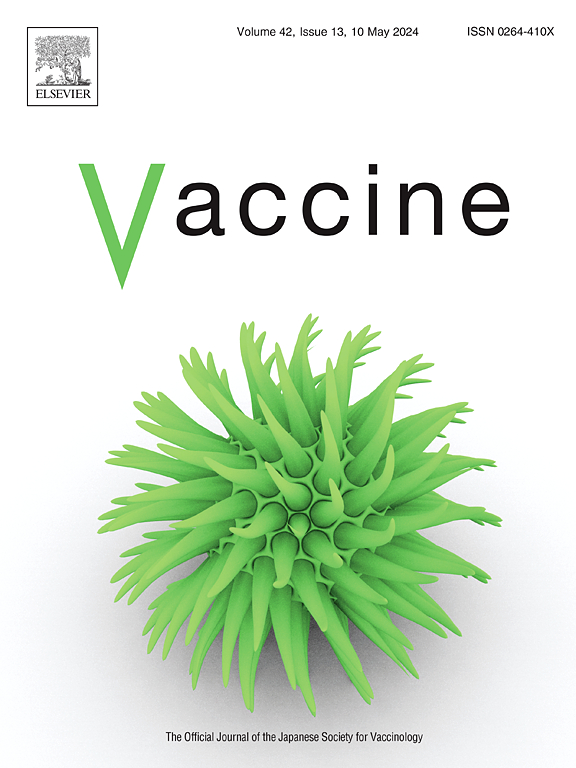Protective efficacy of two novel Klebsiella pneumoniae vaccine antigens, LysM/BON and OMPP1, in a murine model
IF 4.5
3区 医学
Q2 IMMUNOLOGY
引用次数: 0
Abstract
Klebsiella pneumoniae, a multidrug-resistant Gram-negative bacterium, is a major opportunistic pathogen that causes septicaemia as well as respiratory, urinary tract, and soft tissue infections. Infections are difficult to treat and often associated with high mortality rates. Currently, there are no approved vaccines against K. pneumoniae. Previously, we developed a proteomic cell-blot approach to identify bacterial proteins involved in host cell attachment as potential vaccine antigens against Burkholderia spp., Pseudomonas aeruginosa, and verocytotoxigenic Escherichia coli. In this work, using the same approach, we have identified 31 bacterial proteins that contribute to K. pneumoniae attachment to host epithelial cells. Two of them, LysM/BON and OMPP1, were selected for further evaluation as vaccine candidates. E. coli BL21 cells expressing recombinant LysM/BON or OMPP1 demonstrated increased levels of attachment to 16HBE14o− cells. Furthermore, immunisation with both proteins conferred protection against sepsis in a C57BL/6 mouse model of K. pneumoniae infection. Immunisation with OMPP1 or LysM/BON showed 2.69 log10 and 1.54 log10 CFU reductions in bacterial burden, respectively, and also reduced dissemination to the spleen. The antigens stimulated distinct antigen-specific recall response profiles; however, both antigens induced IL-17 and IL-22 expression, especially in NK cells, suggesting that these cytokines may be important in stimulating protection against K. pneumoniae. Both novel antigens have a high potential to be developed as protective vaccine against K. pneumoniae infection.
两种新型肺炎克雷伯菌疫苗抗原LysM/BON和OMPP1在小鼠模型中的保护作用
肺炎克雷伯菌是一种多重耐药革兰氏阴性菌,是一种主要的机会性病原体,可引起败血症以及呼吸道、泌尿道和软组织感染。感染很难治疗,而且往往与高死亡率有关。目前,尚无针对肺炎克雷伯菌的批准疫苗。在此之前,我们开发了一种蛋白质组学细胞印迹方法来鉴定参与宿主细胞附着的细菌蛋白,作为对抗伯克霍尔德氏菌、铜绿假单胞菌和产毒大肠杆菌的潜在疫苗抗原。在这项工作中,使用相同的方法,我们已经确定了31种有助于肺炎克雷伯菌附着在宿主上皮细胞上的细菌蛋白。其中两种,LysM/BON和OMPP1,被选择作为候选疫苗进行进一步评价。表达重组LysM/BON或OMPP1的大肠杆菌BL21细胞显示出对16HBE14o-细胞的附着水平增加。此外,在C57BL/6肺炎克雷伯菌感染小鼠模型中,用这两种蛋白免疫对败血症具有保护作用。用OMPP1或LysM/BON免疫后,细菌负荷分别减少2.69 log10和1.54 log10 CFU,并减少脾脏传播。抗原刺激不同的抗原特异性回忆反应谱;然而,这两种抗原都诱导IL-17和IL-22的表达,特别是在NK细胞中,这表明这些细胞因子可能在刺激对肺炎克雷伯菌的保护中起重要作用。这两种新型抗原都有很大的潜力被开发为肺炎克雷伯菌感染的保护性疫苗。
本文章由计算机程序翻译,如有差异,请以英文原文为准。
求助全文
约1分钟内获得全文
求助全文
来源期刊

Vaccine
医学-免疫学
CiteScore
8.70
自引率
5.50%
发文量
992
审稿时长
131 days
期刊介绍:
Vaccine is unique in publishing the highest quality science across all disciplines relevant to the field of vaccinology - all original article submissions across basic and clinical research, vaccine manufacturing, history, public policy, behavioral science and ethics, social sciences, safety, and many other related areas are welcomed. The submission categories as given in the Guide for Authors indicate where we receive the most papers. Papers outside these major areas are also welcome and authors are encouraged to contact us with specific questions.
 求助内容:
求助内容: 应助结果提醒方式:
应助结果提醒方式:


